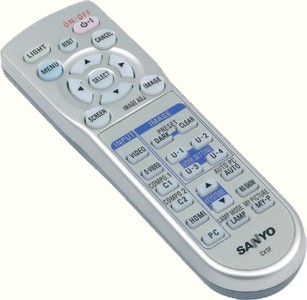Video Projectors: Evolving Towards High Definition
Sanyo PLV-Z3
Sanyo keeps coming out with little brothers for its PLV-Z1. Using low-resolution imagers at first, Sanyo is improving the technical characteristics of its models as time goes on.
The PLV-Z3 has the same functions that account for the success of the Sanyo line, plus new technologies such as TOPAZReal and 10-bit color. There's also a lens shift function that lets you move the projected image up or down and right to left. This clever function has been adopted by many other manufacturers because it makes it easier to set up your projector. Based on a tri-LCD imager with a resolution of 1280x720, and sporting a brightness of 800 lumens and contrast ratio of 2000:1, the PLV-Z3 is one of the rare projectors capable of displaying HDTV signals in true 720p format. That's because the imager is perfectly suited to such signals, and the results are quite impressive as far as the picture is concerned - but we'll get back to that later in the test.
Sanyo has wrapped all this technology in a gray housing with a top-quality finish. The buttons for accessing the menu are in the traditional location on top of the body, and connectivity is very complete, giving you access to HDMI, YUV, S-Video, and composite video. As further evidence of Sanyo's know-how, the lens is protected by a pivoting shutter you can close when you're not using the projector, which keeps dust from building up on the lens. The icing on the cake is that Sanyo has even included a lens cleaning system in case dust does get into the optics. There are small holes under the projector that let you blow air in with a vacuum bulb and remove the dust. It's a clever and effective touch that may save you trips to the repair department.
In Operation
Once connected via YUV, the PLV-Z3 started up in almost tomb-like silence. During our test sessions we absolutely couldn't hear it at all. The speed of the fan, and the resulting noise, are related to the picture modes you select. Of course we chose Low Lamp Mode, not only to extend lamp life, but also to improve the rendering of the blacks and reduce fan noise.
Adjustments are simple to access, yet can be quite complex if you want to control all the possible capabilities of this model. You can access a plethora of image presets corresponding to various uses: movie, game console, PC, lighted living room, etc. The functions are simple, but if you want to go into any detail, you'll need time and patience. If you aren't familiar with video projection, you're better off using the factory presets, which are quite effective.
Among the other adjustments here are focus and zoom rings, and an iris adjustment as well. This last control is a new function that lets more or less light through to adapt the brightness of the image to the ambient light. If you do take the time to work with all the available adjustments, you'll really get the best possible performance from the PLV-Z3.
Get Tom's Hardware's best news and in-depth reviews, straight to your inbox.
Finally, the illuminated remote control is of standard quality and a little confusing at first because it has so many functions. Little by little you will get the hang of it, but it might have been a good idea if Sanyo had built just a little more simplicity into the design.


